The Conversation
Tattooing has held a long tradition in Christianity − dating back to Jesus’ crucifixion

Historically, many Christians got tattoos around Holy Week − usually a cross − to honor Christ’s martyrdom.
Holy Week and Easter are perhaps the most important days in the Christian calendar. Many associate those celebrations with church services, processions, candles, incense, fasting, and penances.
However, there is another tradition that many Christians follow – that of tattooing. Historically, Easter was an important time for tattoos among some Christian groups. Today, Christian tattooing happens in many parts of the world and all year around. Some Christians visiting Jerusalem around Easter will get a tattoo of a cross, or a lamb, usually on their forearms.
As a sociologist of religion and a Jesuit Catholic priest, I have long studied tattoos as religious practices. I have interviewed tattoo artists in Jerusalem, Bethlehem and Loreto in Italy who have been continuing and recreating the tradition of Christian tattooing. Evidence is clear the practice started shortly after Jesus’ crucifixion and spread across Europe in later centuries.
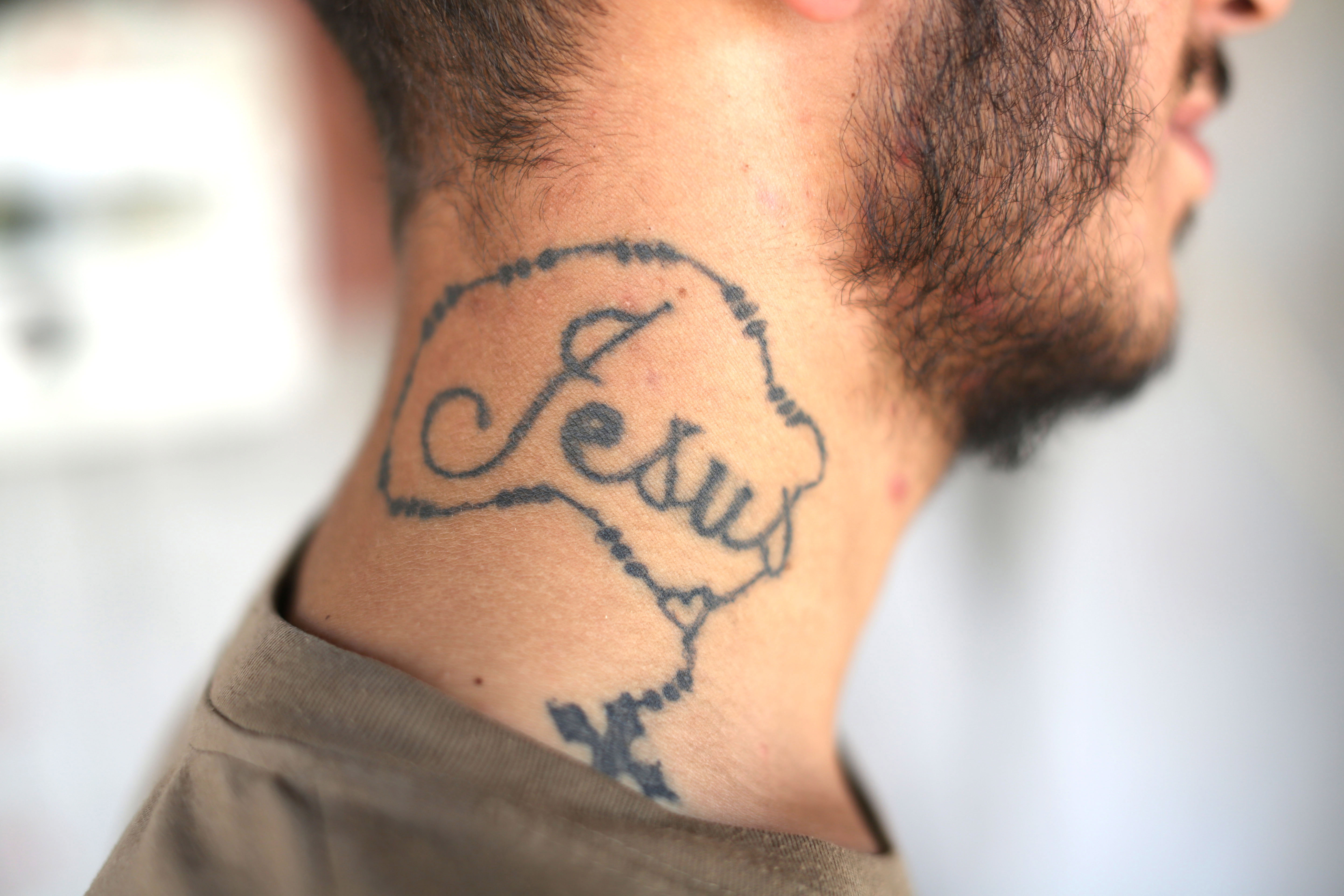
A tattoo saying ‘Jesus’ can be seen on the neck of a soldier belonging to the MFS on August 20, 2017 on the western front lines of Raqqa, Syria. Photo: Rick Findler/Getty Images
The first Christian tattoos
The Romans, like the Greeks, tattooed slaves and prisoners, usually with letters or words on their foreheads that indicated their crime. Soon after Jesus’ death, around the year 30 C.E., they started enslaving and tattooing Christians with the marks “AM” – meaning “ad metalla,” or condemned to work in the mines, a punishment that often resulted in death.
Almost at the same time, Christians who were not enslaved got tattoos of the early Christian signs such as fish or lambs in solidarity and to show that they identified with Jesus.
There were no specific words in Latin or Greek for tattooing, so the words “stizo,” “signum” and “stigma” were used. The word stigma also referred to the marks of nails on Jesus’ hands and foot, as a result of his crucifixion. Christians often got their own “stigmas”: a sign – usually a cross – in Jerusalem to honor Christ’s martyrdom.
The beginning of a tradition
There are several documented accounts of the tradition. One from the third century mentions Christians in present-day Egypt and Syria getting tattoos of fish and crosses.
Another tells about the commentary that Procopius of Gaza, a theologian who lived between 475 and 538 C.E., wrote on the Book of Isaiah after he found that many Christians living in the Holy Land had a cross tattooed on their wrists. “Still others will write on their hand, ‘The Lord’s,’ and will take the name Israel,” he noted.
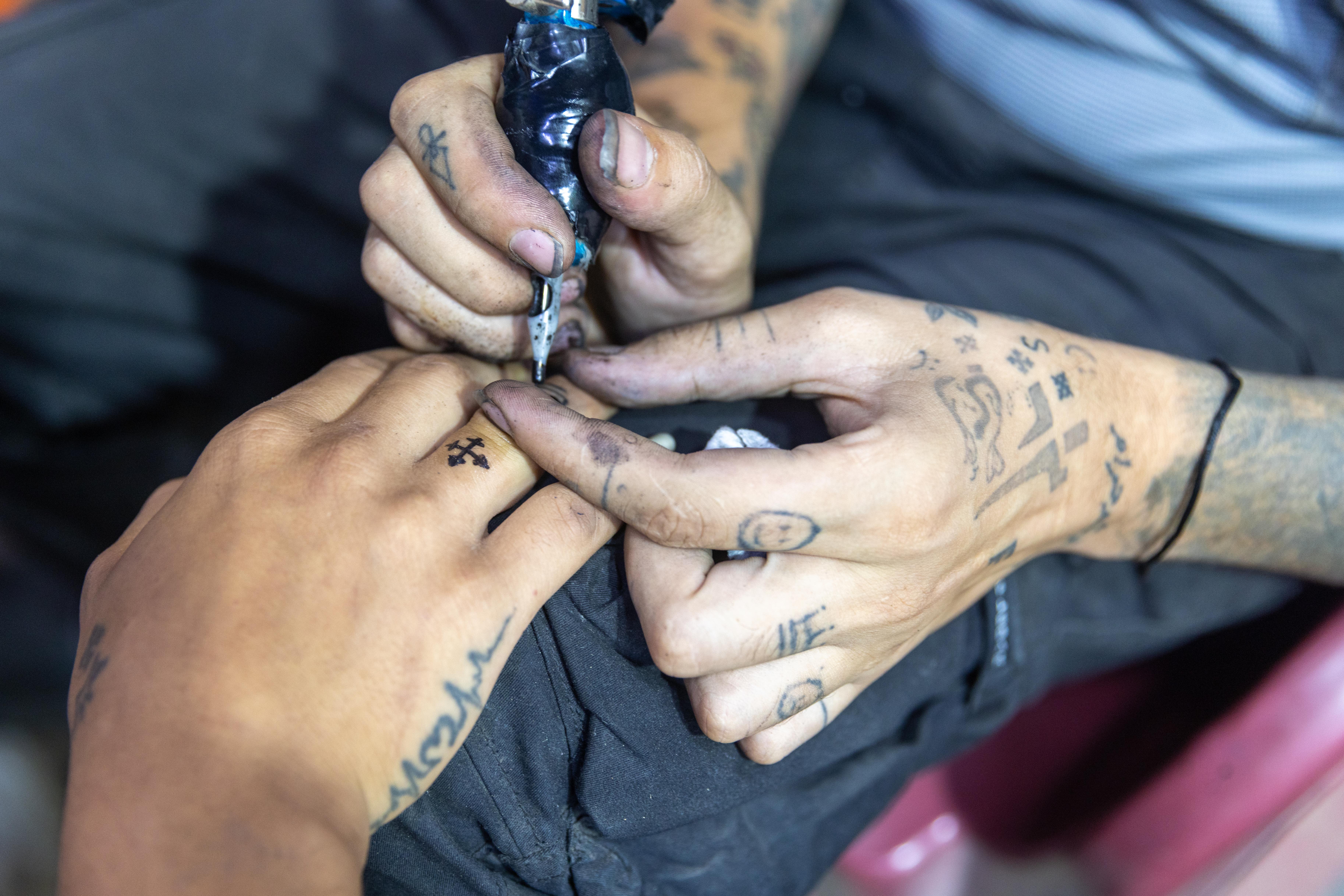
During the Virgin Mary Festival in Dronka, local tattoo artists provide Christian symbols, including crosses, to the attendees, on August 21, 2023 in Assuit, Egypt. (Photo: by Roger Anis/Getty Images)
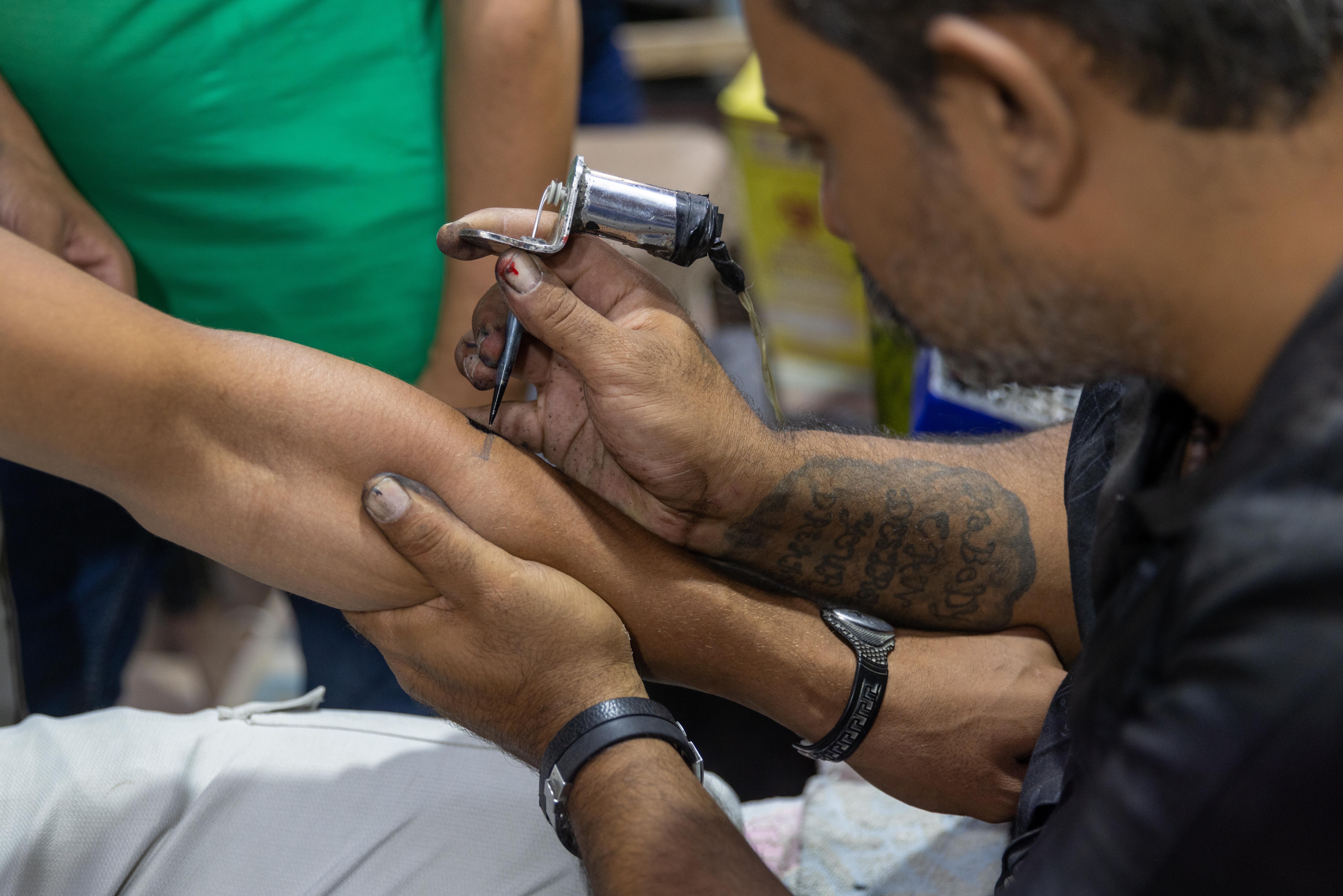
During the Virgin Mary Festival in Dronka, local tattoo artists provide Christian symbols, including crosses, to the attendees, on August 21, 2023 in Assuit, Egypt. Photo: Roger Anis/Getty Images
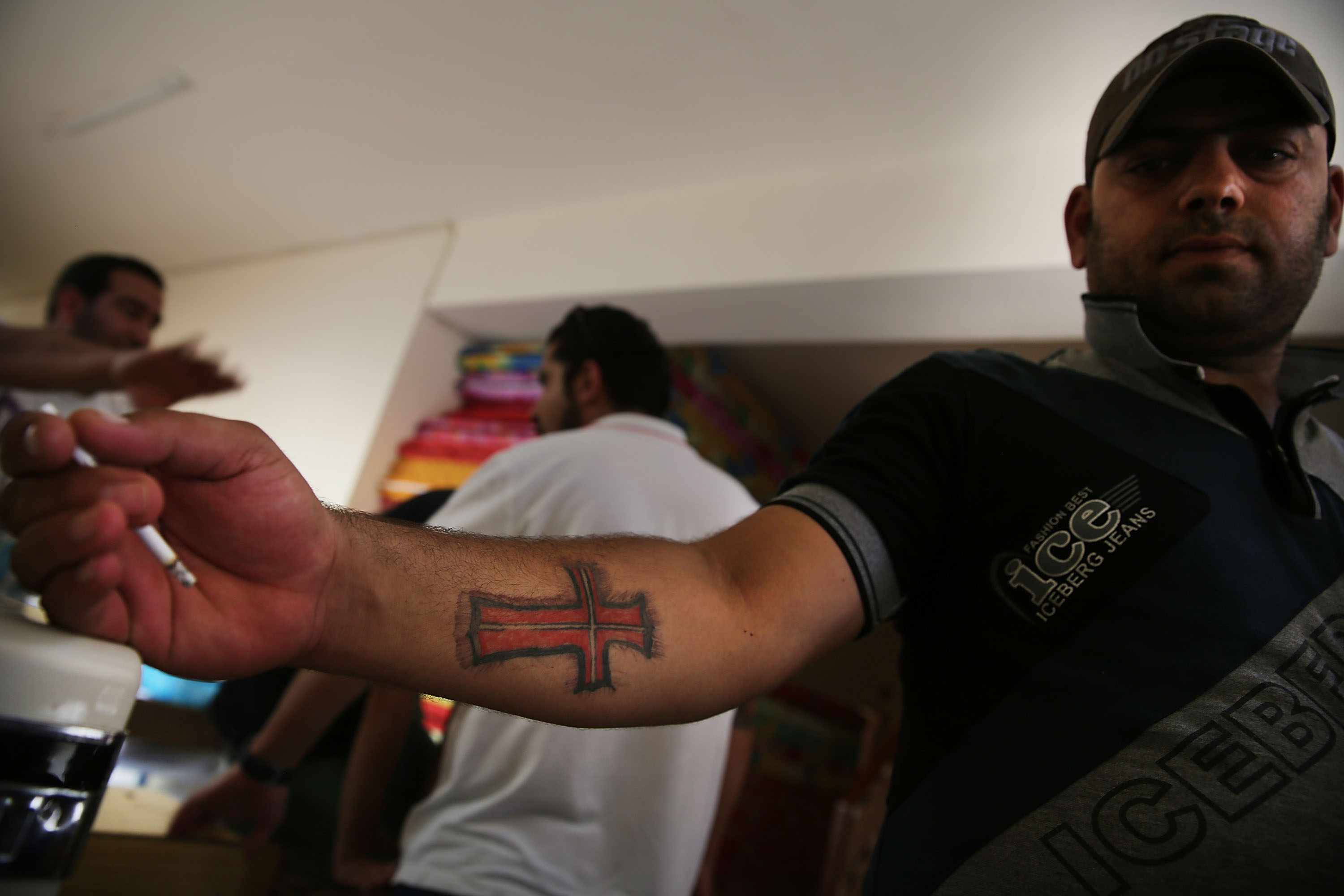
A displaced Iraqi Christian displays a tattoo of a Cross at Saint Joseph’s church where he is living with hundreds of other Christians after having to flee their district on June 26, 2014 in Erbil, Iraq. Photo: by Spencer Platt/Getty Images
When a plague hit the Scythians, nomadic people living around the Black Sea, in 600 C.E., tattoos were believed to provide protection from the deadly disease. Theophylact Simocatta, one of the last historians of late antiquity, mentioned that missionaries among them recommended that “the foreheads of the young be tattooed with this very sign” – meaning that of a cross.
Many testimonies mentioned Crusaders and pilgrims returning from the Holy Land with a tattoo during the Middle Ages – a tradition that continued in early modern times, between the 16th and 18th centuries.
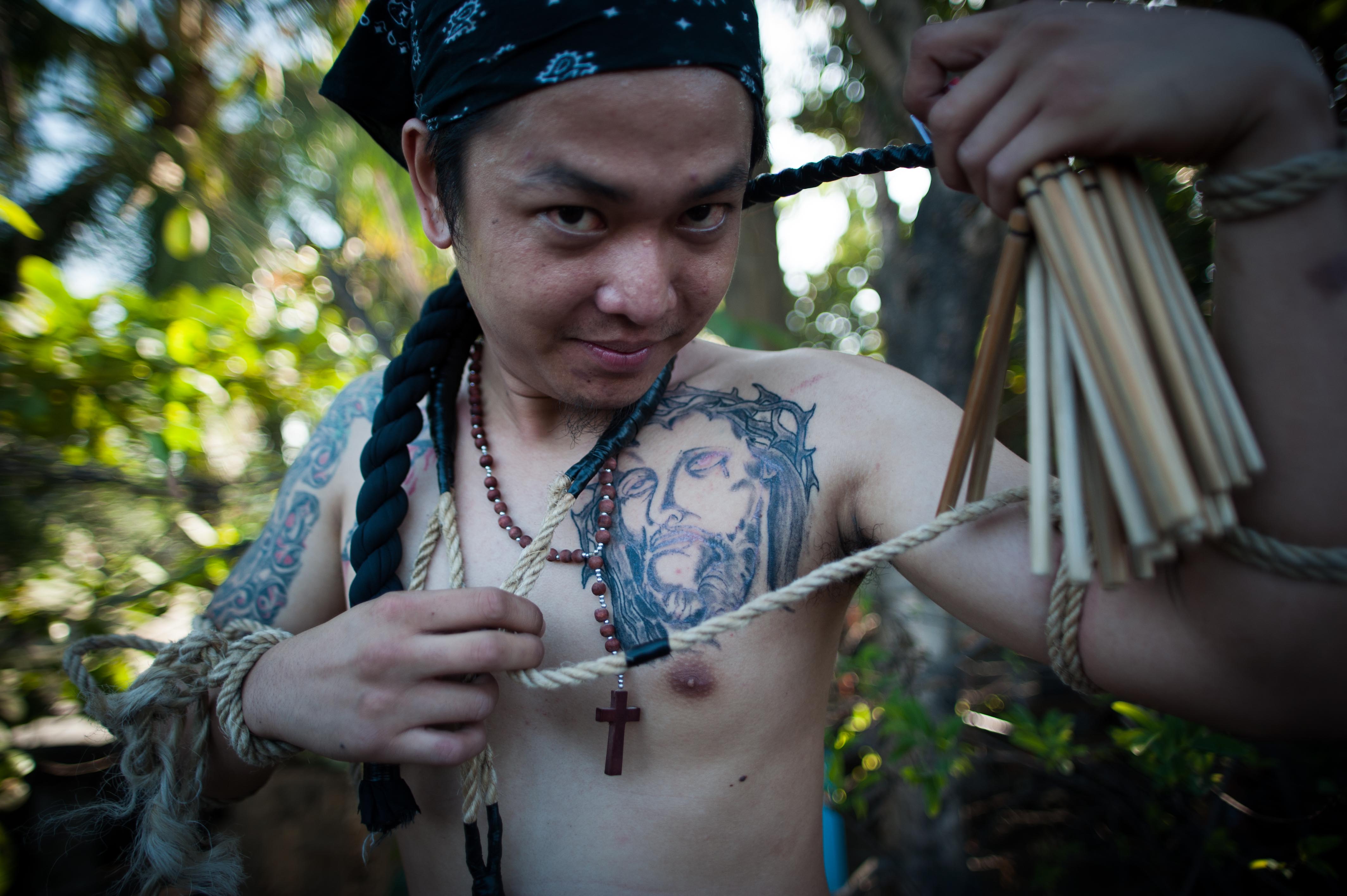
A Catholic devotee shows a tattoo of Jesus Christ during holy week on April 2, 2015 in Pampanga, Philippines. Photo: Dondi Tawatao/Getty Images
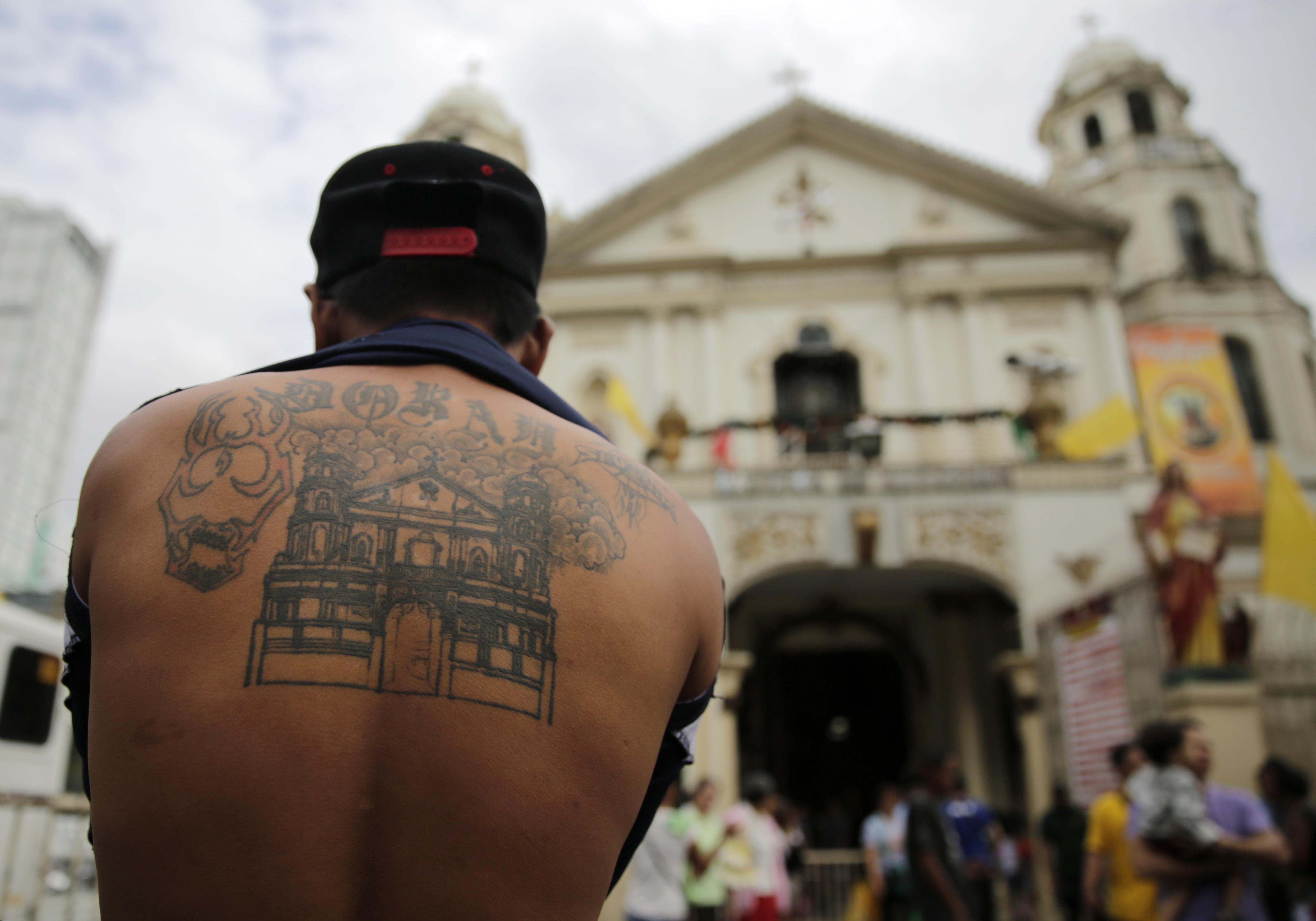
A Filipino devotee displays his tattoo in front of the ‘Quiapo Basilica minore’ days before the Feast of the Black Nazarene in Manila, Philippines, 04 January 2018. EPA-EFE/FRANCIS R. MALASIG
Christian tattoos in Great Britain
Other cultures used tattoos in different ways. When Romans came in contact with the Celts tribes that inhabited the British Isles in 400 C.E., they called them Picts because they were covered in body art.
Pope Gregory the Great sent envoys to convert the Celts to Christianity, followed by a visit from another Vatican delegation. While missionaries were against “pagan tattooing,” both delegations agreed that tattoos done for the Christian god were fine. The members of the second delegation in the late 700s even said, “If anyone were to undergo this injury of staining for the sake of God, he would receive a great reward for it.”
Similar was the conclusion of the Northumbria Council, a church gathering in Northern England in 787: Tattoos done for the right god were acceptable. At that time, the Anglo-Saxon elite also had tattoos; the bishop of York, Saint Wilfrid, for example, got a tattoo of a cross.
Tattoos in Italy
Around the 1300s, as the Christian kingdoms in the Holy Land were losing control with the coming of the Ottomans, there appeared in Italy shrines called “Sacri Monti.” These shrines were placed on “holy mountains” where devotees could pilgrimage safely, instead of risking their lives going to Jerusalem, which by then was under the control of the Ottomans.
These shrines were established in cities such as Naples, Varallo, and Loreto. Pilgrims could get tattoos in some of these shrines. One place was Loreto’s sanctuary, established in the early 1300s. A relic from the “Holy House,” which, according to the Christian tradition, is the house where the Virgin Mary is believed to have received the news that she will bear God’s son, was brought to Loreto’s sanctuary.
Tattooing in Loreto’s sanctuary was a communal activity, done by carpenters, shoemakers, and artisans, who brought their stalls and tools to the main square during the days of celebrations and tattooed whoever wanted to get a mark of their devotion. These tattoos typically used wood planks for transferring the design on the body, like a stamp. However, the city of Loreto banned tattooing for hygienic reasons in 1871, according to Caterina Pigorini Beri, an anthropologist, who was one of the first to document the practice.
But people kept getting them. A shoemaker, Leonardo Conditti, was among those who kept doing tattoos in hiding during the 1940s.
From the 1200s to the 1700s, the custom of Christian tattooing was prevalent in Europe among peasants, seafarers, soldiers, and artisans as much as among nuns and monks. They were getting crosses, images of the Virgin Mary, the name of Jesus, and some sentences from the Bible.
Following the Renaissance, however, European culture came to associate tattoos with those considered “uncivilized,” such as people in the colonies, criminals, and poorer Catholics. Many European intellectuals viewed Catholicism as a superstition more than a real religion.
The word “tattoo” came to the Western languages after the French admiral and explorer Louis de Bougainville and British explorer James Cook returned from their trips to the South Pacific at the end of the 1700s. There, they saw local people getting marks on their bodies and using the word “tatau” to name those drawings. However, it does not mean that tattoos came back at that time. They had never left.
The practice today
These days, some churches in the Middle East, such as some Coptic Christian churches in Egypt, incorporate the practice of getting a tattoo into the baptismal rituals.
Indeed, Holy Land tattooing has never stopped. Wassim Razzouk, whom I interviewed in 2022, is a 27th-generation tattooist – his family has been marking pilgrims in Jerusalem since 1300. Razzouk claims to have some of the 500-year-old wood planks his family used for tattooing.
Another tattoo artist whom I interviewed, Walid Ayash, does pilgrimage tattoos for those who visit the Nativity church in Bethlehem – a beloved custom among Arab Christians. He said that tattooing happens all year around, as long as there are pilgrims visiting the Nativity church. Although this year, as a result of the war in Gaza, Israeli authorities have restricted access to Jerusalem and Bethlehem.
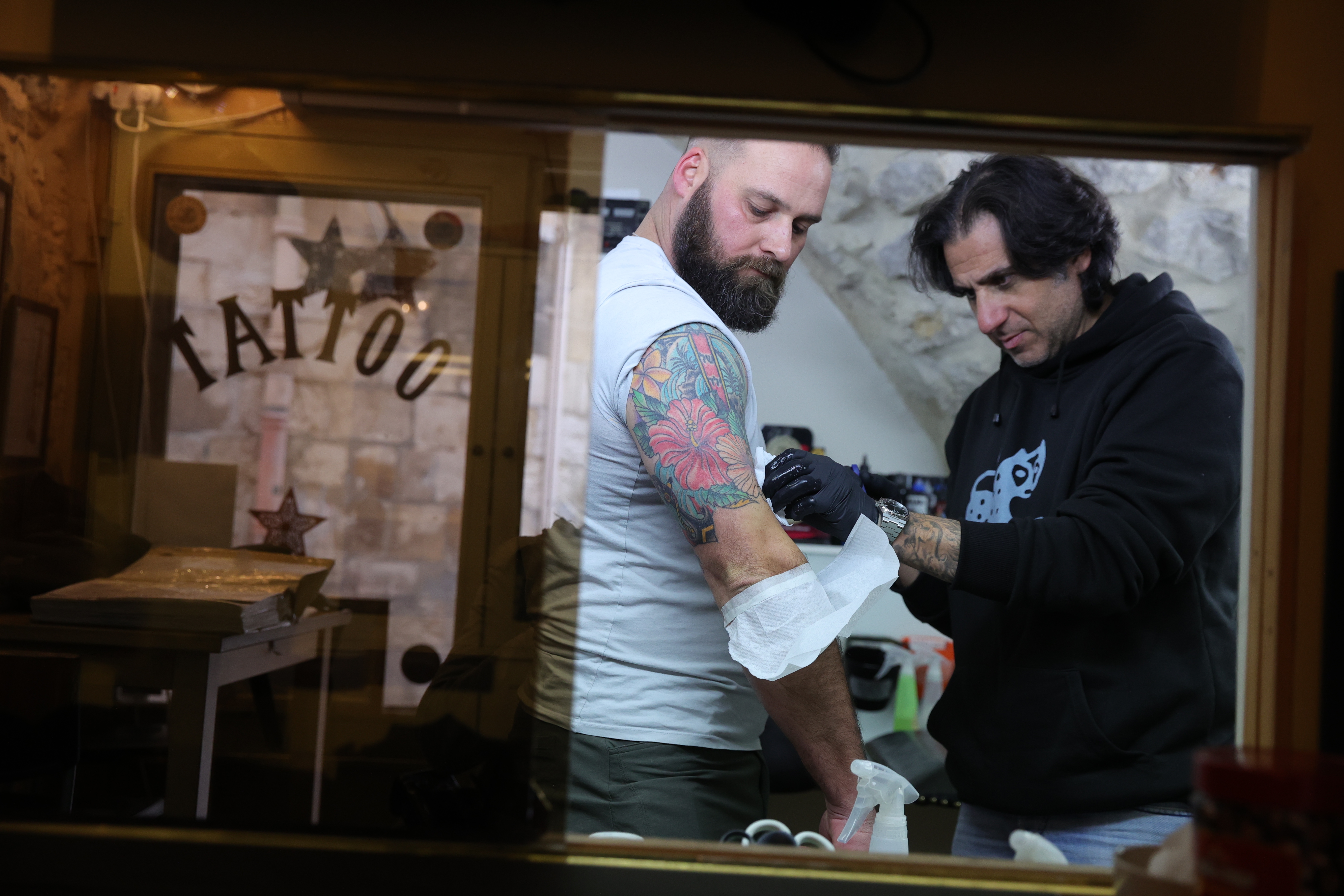
Wassim Razzouk (R) is seen in a mirror as he prepares to stitch a tattoo on an American pilgrim’s arm at the Razzouk Tattoo store in the Old City of Jerusalem, 02 January 2023. Wassim Razzouk is representing the 27th generation of his family to work as tattooists in Jerusalem since the year 1300. The Razzouk family, Coptic Christians who once migrated from Egypt, tattoos pilgrims who visit the holy city of Jerusalem with religious motives as souvenirs, based on ancient tattoo seals of which some are hundreds of years old. Most Coptic Christians from Egypt are known for having Christian-themed tattoos to mark their religious belonging in the Muslim majority Egypt. EPA-EFE/ABIR SULTAN
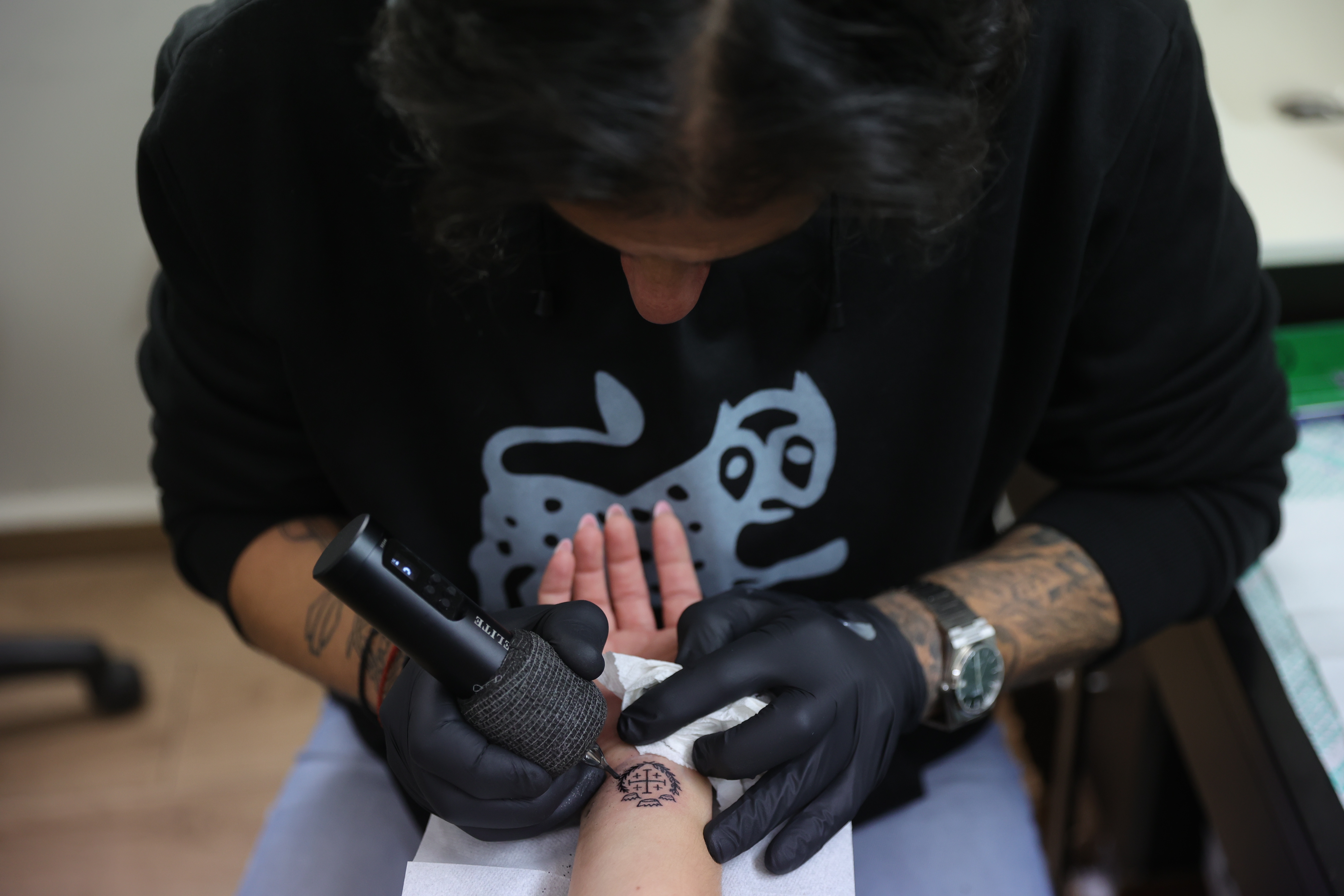
Wassim Razzouk stitches a religious motive tattoo on an African pilgrim’s arm at the Razzouk Tattoo store in the Old City of Jerusalem, 02 January 2023. EPA-EFE/ABIR SULTAN
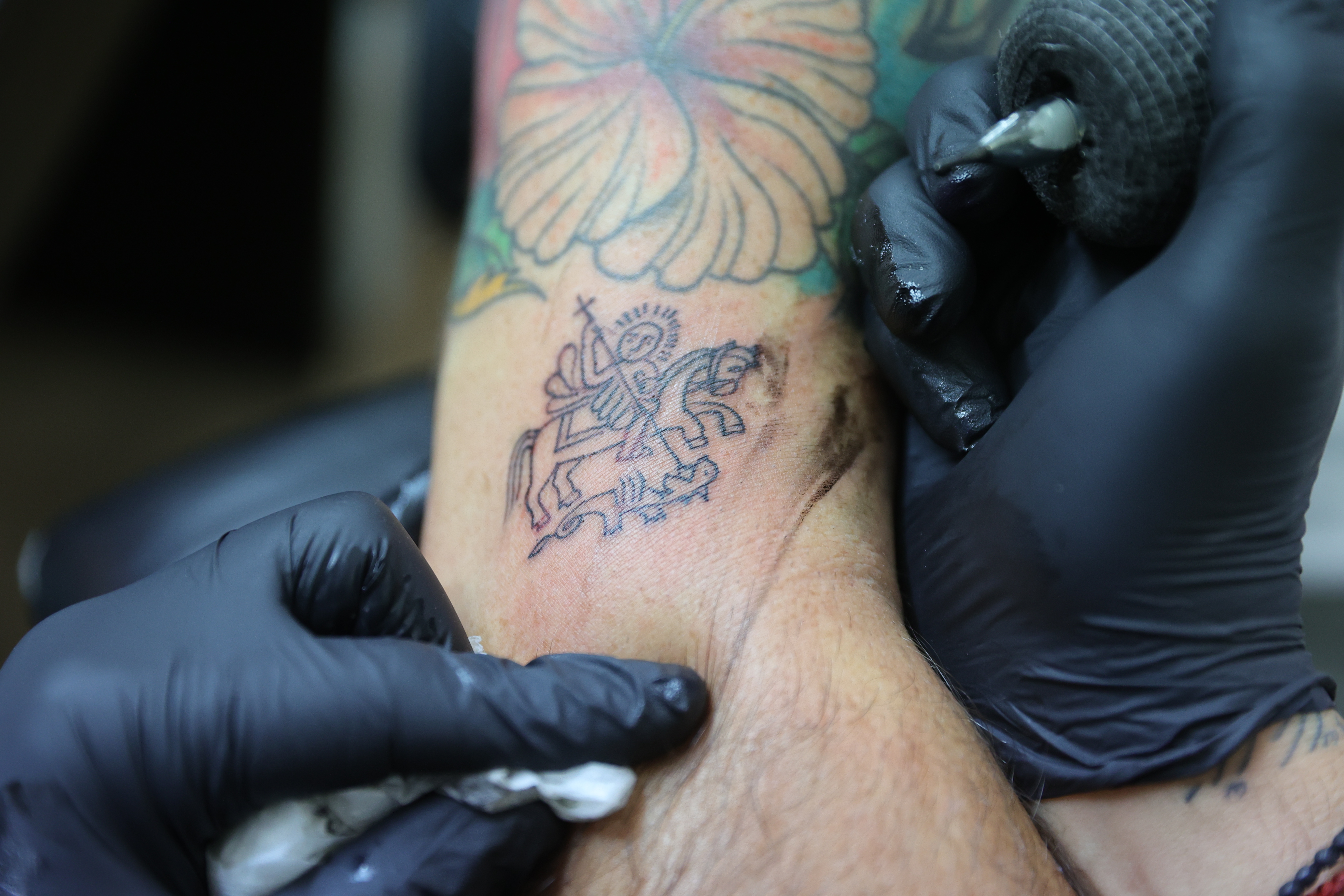
Wassim Razzouk stitches a religious motive tattoo on an American pilgrim’s arm at the Razzouk Tattoo store in the Old City of Jerusalem, 02 January 2023. EPA-EFE/ABIR SULTAN
In Italy, artist Jonatal Carducci is working on recovering the tradition of religious tattooing in Loreto. In a 2023 interview with me, he explained how he has painstakingly replicated the designs of the wood planks, which are both in the Museum of the Holy House and the Folkloric Museum of Rome. In 2019, he opened a parlor where Leonardo Conditti used to work. Visitors to the parlor can choose among more than 60 designs for their tattoos, including the Virgin Mary of Loreto, crosses and representations of Jesus’ heart.
This Easter, as some Christians get tattoos, this history might serve as a reminder of tattooing as a legitimate Christian practice, one that has been in use since the beginnings of the Common Era. DM
This story was first published in The Conversation. Gustavo Morello is a Professor of Sociology at Boston College.




















 Become an Insider
Become an Insider
The Bible warns against tattoos in Leviticus 19:28 (Amplified) which says, “Ye shall not make any cuttings in your flesh for the dead, nor print or tattoo any marks upon you: I am the Lord.”
Yeah, and Leviticus prohibits consuming bacon. And wearing mixed thread clothing. Get real. Time to bin this version of goat-herders’ reality. Leviticus 25:44ff also permits slavery. Let’s just cherry-pick whatever.
Don’t see any cherry picking. Keep to the subject. Do you dispute that the bible is against tattoos.
If you want to discuss the other subjects you refer to fine, but open a new thread.
Yes interesting that the article doesn’t incorporate that. Of course much of the law laid out in Leviticus and other parts of the OT, particularly in the Pentateuch, is considered by Christians to be fulfilled by Jesus and therefore no longer followed. Paul’s teachings on the dietary requirements that were part of Torah are indicative and I’m sure most Christians would include this injunction about tattoos along with that. Likewise Peter’s vision before visiting Cornelius. Still it is interesting that tattooing begun, it seems, well before teachings like these came about.
Good reply
The Bible only reports at this point that a person with self-empowered divine authority demands that the addressees of this scripture refrain from the practice of tattooing. No reason is given here, one can only speculate about it. Perhaps competing groups that worshiped a different deity used tattoos as a sign of their unity? Anyway, why would Christians over a thousand years later consider this practice unchristian?
How wonderful it is to be corrected!
Wear it like you mean it!
Let’s hope the needles are cleaned with more than holy water. Aids has not gone away.
there was this blond who dated anybody:
religion, color, race, status, age meant nothing to her,
if a man asked her on a date,
she said yes,
and she was very generous, i might add.
BUT, she never dated men with tattoos.
she said she does not like another girls name in her mouth.
Found this article to be most informative.
Think that tattoo’s in the “Christian Western World” was seen to be “anti-Christian”.
My viewpoint is starting to shift.
Thankfully
I have never heard of C E for Common Era
Culture & religion are 2 factors that have kept people bonded as communities. This prevented these communities becoming slaves to the elites.
There is a big push to divide communities by immigration & sowing seeds of differences. While true Christian faith does not allow tattoos, this author is trying to make it be as if it is a accepted norm with the intention of sowing division amoung Christians.
My people perish because of scanty of knowledge.
Hosea 4:6 – for people who are not biblically literate, you should cite the source. Otherwise some might think that the saying came from your own wisdom. You could also be suspected of plagiarism.
An interesting work about the tradition of tattooing Christian symbols. But what is the reaction of some who consider themselves Christians? Didn’t Jesus, on whom they rely, confront the Pharisees and scribes for their literal interpretation of the Torah and experience their lack of love for humanity? What about “Phariseeism” in Christian denominations and private churches, which increasingly represent a successful business model around the world at the expense of gullible people?
I sat in enough criminal courts in the 1990s to always associate tattoos with criminals, especially ones who had previously jail terms.
From memory it was a Peter Cook sketch where the joke runs along the line that he likes a man with tattoos because it shows he has convictions. Lots of convictions…
One of the funniest cases was a chap who had dotted lines around his neck with “cut here” instructions. Of course he used make up to cover them for the trial, but he did not realise that the make up rubbed off and by the end of the day all the jury could see his tattoo. He got more conviction….